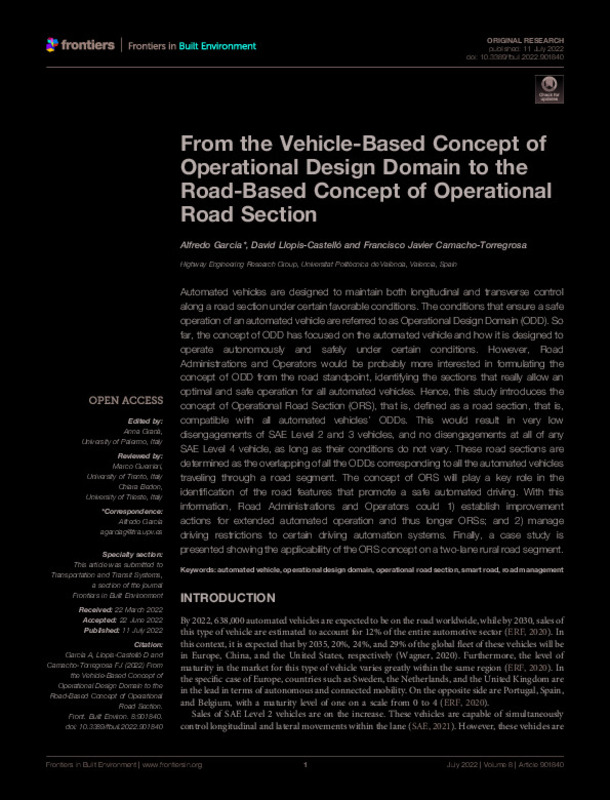JavaScript is disabled for your browser. Some features of this site may not work without it.
Buscar en RiuNet
Listar
Mi cuenta
Estadísticas
Ayuda RiuNet
Admin. UPV
From the Vehicle-Based Concept of Operational Design Domain to the Road-Based Concept of Operational Road Section
Mostrar el registro sencillo del ítem
Ficheros en el ítem
| dc.contributor.author | García García, Alfredo
|
es_ES |
| dc.contributor.author | Llopis-Castelló, David
|
es_ES |
| dc.contributor.author | Camacho-Torregrosa, Francisco Javier
|
es_ES |
| dc.date.accessioned | 2022-11-22T19:03:01Z | |
| dc.date.available | 2022-11-22T19:03:01Z | |
| dc.date.issued | 2022-07-11 | es_ES |
| dc.identifier.uri | http://hdl.handle.net/10251/190060 | |
| dc.description.abstract | [EN] Automated vehicles are designed to maintain both longitudinal and transverse control along a road section under certain favorable conditions. The conditions that ensure a safe operation of an automated vehicle are referred to as Operational Design Domain (ODD). So far, the concept of ODD has focused on the automated vehicle and how it is designed to operate autonomously and safely under certain conditions. However, Road Administrations and Operators would be probably more interested in formulating the concept of ODD from the road standpoint, identifying the sections that really allow an optimal and safe operation for all automated vehicles. Hence, this study introduces the concept of Operational Road Section (ORS) that is defined as a road section that is compatible with all automated vehicles¿ ODDs. This would result in very low disengagements of SAE Level 2 and 3 vehicles, and no disengagements at all of any SAE Level 4 vehicle, as long as their conditions do not vary. These road sections are determined as the overlapping of all the ODDs corresponding to all the automated vehicles traveling through a road segment. The concept of ORS will play a key role in the identification of the road features that promote a safe automated driving. With this information, Road Administrations and Operators could (a) establish improvement actions for extended automated operation and thus longer ORSs; and (b) manage driving restrictions to certain driving automation systems. Finally, a case study is presented showing the applicability of the ORS concept on a two-lane rural road segment. | es_ES |
| dc.description.sponsorship | This research is part of the PIARC's Special Project "Smart Roads Classification," funded by World Road Association-PIARC. | es_ES |
| dc.language | Inglés | es_ES |
| dc.publisher | Frontiers Media | es_ES |
| dc.relation.ispartof | Frontiers in Built Environment | es_ES |
| dc.rights | Reconocimiento (by) | es_ES |
| dc.subject | Automated vehicle | es_ES |
| dc.subject | Operational design domain | es_ES |
| dc.subject | Operational road section | es_ES |
| dc.subject | Smart road | es_ES |
| dc.subject | Road management | es_ES |
| dc.subject.classification | INGENIERIA E INFRAESTRUCTURA DE LOS TRANSPORTES | es_ES |
| dc.title | From the Vehicle-Based Concept of Operational Design Domain to the Road-Based Concept of Operational Road Section | es_ES |
| dc.type | Artículo | es_ES |
| dc.identifier.doi | 10.3389/fbuil.2022.901840 | es_ES |
| dc.rights.accessRights | Abierto | es_ES |
| dc.contributor.affiliation | Universitat Politècnica de València. Escuela Técnica Superior de Ingenieros de Caminos, Canales y Puertos - Escola Tècnica Superior d'Enginyers de Camins, Canals i Ports | es_ES |
| dc.description.bibliographicCitation | García García, A.; Llopis-Castelló, D.; Camacho-Torregrosa, FJ. (2022). From the Vehicle-Based Concept of Operational Design Domain to the Road-Based Concept of Operational Road Section. Frontiers in Built Environment. 8:1-8. https://doi.org/10.3389/fbuil.2022.901840 | es_ES |
| dc.description.accrualMethod | S | es_ES |
| dc.relation.publisherversion | https://doi.org/10.3389/fbuil.2022.901840 | es_ES |
| dc.description.upvformatpinicio | 1 | es_ES |
| dc.description.upvformatpfin | 8 | es_ES |
| dc.type.version | info:eu-repo/semantics/publishedVersion | es_ES |
| dc.description.volume | 8 | es_ES |
| dc.identifier.eissn | 2297-3362 | es_ES |
| dc.relation.pasarela | S\468844 | es_ES |
| dc.contributor.funder | ASSOCIATION MONDIALE DE LA ROUTE | es_ES |
| dc.subject.ods | 03.- Garantizar una vida saludable y promover el bienestar para todos y todas en todas las edades | es_ES |
| dc.subject.ods | 09.- Desarrollar infraestructuras resilientes, promover la industrialización inclusiva y sostenible, y fomentar la innovación | es_ES |
| dc.subject.ods | 11.- Conseguir que las ciudades y los asentamientos humanos sean inclusivos, seguros, resilientes y sostenibles | es_ES |
| upv.costeAPC | 2500 | es_ES |








